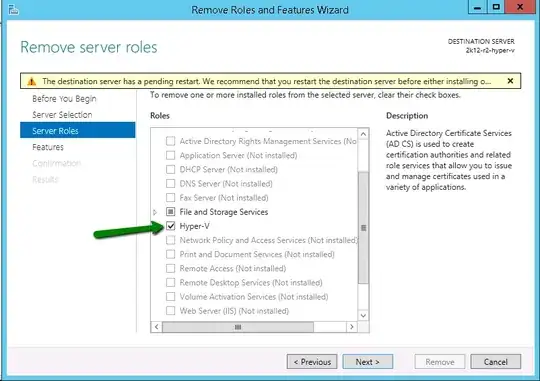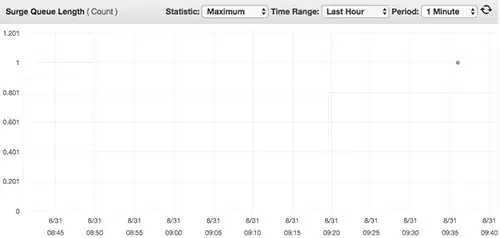A problem: It seems like every single request to our application ends up in ELB surge queue
Example of a surge queue chart:

We have a classic ELB on AWS with multiple EC2 boxes behind it. ELB listeners setup in a next way
LB Protocol LB Port Instance Protocol Instance Port Cipher SSL Certificate
TCP 80 TCP 80 N/A N/A
On an EC2 instance we have an nginx server with next nginx.conf:
user nginx;
worker_processes 3;
pid /var/run/nginx.pid;
worker_rlimit_nofile 8192;
worker_rlimit_sigpending 32768;
events {
worker_connections 2048;
multi_accept on;
use epoll;
accept_mutex off;
}
http {
sendfile on;
tcp_nopush on;
tcp_nodelay on;
keepalive_timeout 65;
types_hash_max_size 2048;
map_hash_bucket_size 128;
server_tokens off;
client_max_body_size 0;
server_names_hash_bucket_size 256;
include /etc/nginx/mime.types;
default_type application/octet-stream;
log_format main '$remote_addr - $remote_user [$time_local] "$request" '
'$status $body_bytes_sent "$http_referer" '
'"$http_user_agent" "$http_x_forwarded_for" $request_time';
access_log /app/log/nginx/access.log main;
error_log /app/log/nginx/error.log;
gzip on;
gzip_disable "msie6";
gzip_vary on;
gzip_comp_level 4;
gzip_buffers 16 8k;
gzip_http_version 1.1;
gzip_types text/plain text/css application/json application/x-javascript text/xml application/xml application/xml+rss text/javascript;
client_body_temp_path /app/tmp/nginx;:q
include /etc/nginx/sites-enabled/*;
upstream tomcat {
server localhost:8080;
}
upstream httpd {
server localhost:9000;
}
upstream play {
server localhost:9000;
}
and vhost sites.conf
log_format proxylog '$remote_addr - $remote_user [$time_local] "$request" '
'$status $body_bytes_sent "$http_referer" '
'"$http_user_agent" "$proxy_protocol_addr" $request_time';
server {
server_name www.my-site.com;
rewrite ^(.*) http://my-site.com$1 permanent;
}
server {
listen 80 proxy_protocol;
listen 443 ssl proxy_protocol;
ssl_certificate /etc/nginx/my-certificate.crt;
ssl_certificate_key /etc/nginx/my-key.key;
ssl_protocols TLSv1 TLSv1.1 TLSv1.2;
ssl_ciphers "SECRET";
ssl_prefer_server_ciphers on;
set_real_ip_from 10.0.0.0/8;
root /app/websites/my-site.com/httpdocs;
index index.html index.htm;
real_ip_header proxy_protocol;
server_name my-site.com;
access_log /app/log/nginx/my-site.com.access.log proxylog buffer=16k flush=2s;
error_log /app/log/nginx/my-site.com.error.log;
charset utf-8;
location /foo {
proxy_pass http://play;
proxy_http_version 1.1;
proxy_set_header Upgrade $http_upgrade;
proxy_set_header Connection "upgrade";
}
location /bar {
add_header Access-Control-Allow-Origin "*" always;
add_header Access-Control-Allow-Methods "GET,POST,OPTIONS,DELETE,PUT" always;
add_header 'Access-Control-Allow-Headers' 'Origin, X-Requested-With, Content-Type, Accept, User-Agent, Authorization, Referer, Timestamp' always;
add_header Access-Control-Allow-Credentials true always;
proxy_pass http://play;
proxy_http_version 1.1;
proxy_set_header Upgrade $http_upgrade;
proxy_set_header Connection "upgrade";
}
location / {
add_header Access-Control-Allow-Origin "*" always;
add_header Access-Control-Allow-Methods "GET,POST,OPTIONS,DELETE,PUT" always;
add_header 'Access-Control-Allow-Headers' 'Origin, X-Requested-With, Content-Type, Accept, User-Agent, Authorization, Referer, Timestamp' always;
add_header Access-Control-Allow-Credentials true always;
real_ip_header proxy_protocol;
set_real_ip_from 10.0.0.0/8;
proxy_read_timeout 90s;
proxy_set_header X-Real-IP $proxy_protocol_addr;
proxy_set_header X-Forwarded-For $proxy_protocol_addr;
proxy_set_header X-Forwarded-Host $host;
proxy_set_header X-Forwarded-Server $host;
proxy_pass http://play;
proxy_set_header Host $http_host;
}
location ~ ^/(images|css|js|html) {
root /app/websites/my-site.com/httpdocs;
}
error_page 404 /404.html;
error_page 500 502 503 504 /50x.html;
location = /50x.html {
root html;
}
}
I'm limiting possible suspects of a problem to ELB and nginx, and not the most obvious – actual web server processing requests, because in one of my tests I completely removed java application, and replaces it with a dummy node.js server which was replying 'hello world' to every request, and I was still getting all those requests logged in surge queue.
I also tried adjusting worker_processes and keepalive_timeout to see if it affects anything, and it doesn't.
What bothers me, is that this surge queue of 1 doesn't affect performance of a service, as it seems like requests tend to stay there fractions of seconds, but what I don't understand is why even a single request ends up passing through surge queue.
